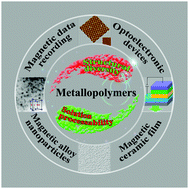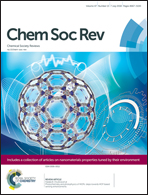A molecular approach to magnetic metallic nanostructures from metallopolymer precursors
Abstract
In recent years, metallopolymers have attracted much attention as precursors to generate magnetic metal/metal alloy nanoparticles (NPs) through pyrolysis or photolysis because they offer the advantages of ease of solution processability, atomic level mixing and stoichiometric control over composition. The as-generated NPs usually possess narrow size distributions with precise control of composition and density per unit area. Moreover, patterned NPs can be achieved on various substrates in this way owing to the good film-forming property of metallopolymers and such work is important for many applications based on metal nanostructures. By combining the merits of both the solution processability of metallopolymers and nanoimprint lithography (NIL), a new platform can be created for fabricating bit-patterned media (BPM) and the next-generation of nanoscale ultra-high-density magnetic data storage devices. Furthermore, most of these metallopolymers can be used directly as a negative-tone resist to generate magnetic metallic nanostructures by electron-beam lithography and UV photolithography. Self-assembly and subsequent pyrolysis of metalloblock copolymers can also afford well-patterned magnetic metal or metal alloy NPs in situ with periodicity down to dozens of nanometers. In this review, we highlight the use of metallopolymer precursors for the synthesis of magnetic metal/metal alloy NPs and their nanostructures and the related applications.



 Please wait while we load your content...
Please wait while we load your content...